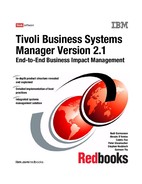
144 Tivoli Business Systems Manager Version 2.1: End-to-End Business Impact Management
? Grouped resources: Using this method, all resources that a BSV depends on
are made a first-level dependant of the BSV. Other resourceson which the
BSV is not directly dependent are grouped in one or more sub-BSVs.
Figure 5-4 shows the conceptual BSV structure.
Figure 5-4 Grouped resource BSV for Remote Banking

Chapter 5. Implementation planning 145
Table 5-6 shows the pros and cons of each method. The following criteria were
evaluated:
? Logical cause/effect relationship of the object: Does the causal relationship of
the objects in the view generate the correct propagation behavior? For
example, if the host cannot be pinged, then it causes the server application to
be unavailable.
? Ease of identifying a problem: Determine whether a problem is directly
caused by the BSV component or by something else the component is
dependent on. This can be seen from a tree view or a hyperview.
? Ease of maintenance: As with automatic placement of an object under the
BSV view, automatic instance filtering can only be implemented for objects
under BSV folder objects, not a BSV logical object from a physical object.
? Effect on the business impact view: We called this a fan effect because the
business impact view looks like a fan with a lot of parents for an object, thus
we cannot really perform a business impact analysis.
Based on Table 5-6, we decided to use the separate BSV design for implementing
our BSV.
Table 5-6 Pro and cons of BSVs creation
Type Cause effect Identification Maintenance Business
impact
No hierarchy No No Automated Not affected
Original
hierarchy
Some Yes No Not affected
Inverted
hierarchy
Yes Yes No Great impact
Separate BSV Some Yes Automated Not affected
146 Tivoli Business Systems Manager Version 2.1: End-to-End Business Impact Management
..................Content has been hidden....................
You can't read the all page of ebook, please click here login for view all page.
